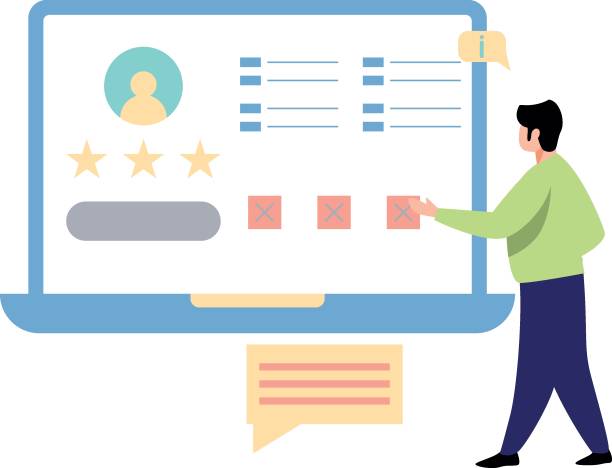Introduction to the Importance of Multilingual Website Design in Today’s World

In the era of #globalization and the development of #e-commerce, online presence is no longer limited by geographical boundaries.
For any business that dreams of expanding its activities to international markets, multilingual website design is an undeniable necessity.
This approach not only helps you reach more audiences but also increases your brand’s credibility and professionalism on a global scale.
A website that can offer its content in different languages allows businesses to connect with users from various cultures and languages and meet their needs.
This section provides an explanatory content for you to understand the importance of this topic.
Have you ever thought about the impact on your business of losing potential customers due to not supporting their language? According to global statistics, a significant portion of internet users prefer their native language for searching and shopping.
Therefore, not providing content in their native language means missing out on countless business opportunities.
Language is the primary tool for communication, and this principle holds true in the digital space.
This not only leads to increased traffic but also significantly boosts conversion rates, as users access information in a more comfortable and understandable environment.
Multilingual website design is considered a strategic investment for the future of any modern business seeking to compete in the international arena.
Does your current website showcase your brand’s credibility as it should? Or does it drive away potential customers?
Rasaweb, with years of experience in professional corporate website design, is your comprehensive solution.
✅ A modern, beautiful, and brand-aligned website
✅ Significant increase in lead generation and new customers
⚡ Contact Rasaweb now for a free corporate website design consultation!
Key Benefits of Multilingual Website Design for Businesses

Multilingual website design brings numerous benefits to businesses, extending beyond merely reaching more audiences.
Firstly, it helps you enhance your brand’s #credibility at an international level.
When your website provides quality content in various languages, it demonstrates your respect for global audiences and your seriousness in expanding your operations.
This, in turn, increases user trust and consequently improves #conversion_rates.
Secondly, improving SEO and search engine ranking is another significant achievement.
Search engines like Google prioritize multilingual websites in search results for users from different regions due to their better user experience.
This section provides an analytical content that shows you how this investment will yield returns.
By correctly using hreflang tags and appropriate URL structure, you can ensure that each language version of your website ranks well for its target audience in search engines.
Furthermore, multilingual website design enables entry into new markets and the discovery of unknown business opportunities.
By understanding different needs and cultures, you can localize your products and services and communicate more effectively with potential customers.
This approach not only leads to increased sales but also makes you more resilient against domestic market fluctuations and ensures the stability of your business.
Challenges and Technical Considerations in Implementing a Multilingual Website

Implementing multilingual website design, despite its numerous benefits, also presents specific technical challenges that require careful attention and planning.
One of the most important #challenges is choosing the appropriate #URL_structure for different language versions.
Three main approaches include using subdomains (e.g., en.example.com), subdirectories (e.g., example.com/en), or country code top-level domains (e.g., example.co.uk).
Each of these methods has its own advantages and disadvantages in terms of SEO, management, and hosting.
The specialized content of this section helps you make more informed decisions.
Content management and ensuring translation synchronization across all language versions require a powerful Content Management System (CMS) with native multilingual capabilities or suitable plugins.
Furthermore, #technical_issues related to encoding (such as UTF-8 for supporting various characters), website loading speed in different parts of the world, and the correct use of hreflang tags to inform search engines about language versions are of high importance.
Failure to pay attention to these details can lead to SEO problems and a poor user experience.
Investing in a strong technical structure for multilingual website design will be the foundation of your long-term success in international markets.
| Structure Type | Example | Advantages | Disadvantages |
|---|---|---|---|
| Subdirectory | example.com/en/ | Strong SEO, easier management, sharing of main domain authority | May make regional targeting difficult to understand |
| Subdomain | en.example.com | Clearer language/region separation, potential separate hosting | May not be as strong as subdirectory for SEO |
| Top-Level Domains (ccTLD) | example.co.uk | Best for regional targeting, high local authority | Higher cost, more complex management, need to build authority for each domain |
Choosing the Best Strategy for Website Multilingualism

Choosing the right #multilingual_strategy for your website is a crucial step in the multilingual website design process and should be based on your business objectives, available resources, and target audience.
As mentioned earlier, there are three main options: subdomains, subdirectories, and country code top-level domains (ccTLDs).
This guidance content helps you make the best choice.
Subdirectories (e.g., example.com/en/) are often recommended for many businesses due to their ease of implementation and SEO benefits, as they leverage the main domain’s authority.
This method centralizes content management and is suitable for websites with a large number of pages.
Subdomains (e.g., en.example.com) offer a clearer separation and can be beneficial for websites that require separate hosting or development for each language version, although they might be slightly more complex from an SEO perspective.
Finally, ccTLDs (e.g., example.de for Germany) provide the strongest geographical signal to search engines and are ideal for businesses whose primary goal is deep penetration into a specific market, but they come with higher costs and management complexities.
The decision regarding the structure will have a direct impact on #international_SEO and user experience.
Consulting with multilingual website design specialists can be very helpful at this stage to ensure that your chosen strategy aligns with your long-term business goals.
Are you concerned about your e-commerce site’s low conversion rate and not achieving your desired sales?
Rasaweb is your specialized solution for a successful e-commerce website.
✅ Significant increase in conversion rates and sales
✅ Professional and user-friendly design to ensure customer satisfaction
⚡ Ready for a transformation in online sales? Get a free consultation!
The Importance of Content Translation and Localization in Multilingual Websites

Many believe that multilingual website design merely means word-for-word content translation, but this is a common misconception.
#Translation of content is only part of the broader and more complex process of #localization.
Localization goes beyond translating words; this process involves adapting content to the cultural, social, and even legal aspects of a specific region.
This explanatory content shows you why this is crucial.
For instance, idiomatic expressions, humor, or even colors and images might have different meanings or even be considered offensive in various cultures.
Proper localization means creating content that is not only linguistically correct but also deeply connects with local audiences, conveying a sense of empathy and understanding.
This includes adapting date and time formats, currencies, measurement systems, and even writing style and tone.
Using native and specialized translators familiar with the target culture and market is essential to ensure the quality and accuracy of localization.
A successful multilingual website design is one where users feel the content was written for them from the outset, not merely translated.
This attention to detail not only improves the user experience but also enhances your brand’s credibility and ultimately leads to increased conversion rates.
Localization is an investment that yields significant returns in attracting and retaining international customers.
SEO Optimization for Multilingual Websites

#SEO_optimization for multilingual website design is a complex but vital process that requires a deep understanding of how search engines operate in international markets.
The main goal is to ensure that each language version of your website is displayed to the appropriate audience in search results.
This educational and specialized content teaches you the key steps.
One of the most important tools for multilingual SEO is the correct use of the hreflang tag.
This tag tells search engines that alternative pages exist for specific languages or geographical regions, helping them display the correct page version to the relevant user.
Furthermore, #keyword_research should be conducted separately for each language and region, as keywords and search phrases can differ across cultures.
International SEO tools can be helpful in this regard.
The URL structure, as discussed earlier, also plays a significant role in multilingual SEO.
The choice of subdirectories, subdomains, or ccTLDs should be made with SEO goals in mind.
Also, site loading speed, mobile compatibility, and overall user experience in each language version are all important factors influencing SEO ranking.
Continuous monitoring of SEO performance in each language and making necessary adjustments to improve it are integral parts of success in multilingual website design.
Suitable Tools and Platforms for Multilingual Website Design

Choosing the right #tools and #platforms for multilingual website design can make a significant difference in the ease of its implementation and management.
Various options are available for this purpose, each with its own advantages and disadvantages.
This guidance and specialized content will assist you in your selection.
The most popular methods include using Content Management Systems (CMS) with native multilingual capabilities or powerful plugins.
WordPress, as the most widely used CMS, easily enables multilingual site creation with plugins like WPML or Polylang.
Joomla and Drupal both also have strong built-in multilingual capabilities.
For online stores, platforms like WooCommerce (a WordPress plugin) and Shopify also offer multilingual solutions.
In addition to CMS, Translation Management Systems (TMS) tools like MemoQ or Trados can also be useful for organizing and automating the translation process of large volumes of content.
The choice of the right tool depends on the complexity of the site, your budget, and your team’s expertise.
Thorough review of each platform’s features and support is essential before investing in multilingual website design.
| CMS | Plugin/Main Feature | Advantages | Considerations |
|---|---|---|---|
| WordPress | WPML, Polylang | Comprehensive, flexible, extensive support | May be heavy for very large sites |
| Joomla | Built-in multilingual capability | High performance, SEO-optimized | Slightly harder to learn for beginners |
| Drupal | Built-in multilingual capability | Very powerful and scalable, high security | Requires more technical knowledge |
| Shopify | Shopify Markets, Translation apps | Ease of use for online stores | More limited capabilities in advanced customization |
User Experience and Interface Design in Multilingual Websites

#User_experience (UX) and #interface_design (UI) are key pillars of any website’s success, and their importance doubles in #multilingual_website_design.
A successful multilingual website must not only be technically efficient but also provide a smooth and flawless experience for users from every language and culture.
This explanatory content addresses the importance of this topic.
This includes placing a clear and accessible language selector (usually in the header or footer), ensuring all user interface elements (menus, buttons, error messages) are translated, and maintaining design consistency across all language versions.
It’s important that #website_design supports the expansion or reduction of text length in different languages to prevent layout disruption.
For example, German texts are typically longer than English texts, so sufficient space for text should be considered.
Also, text direction (right-to-left or left-to-right) for languages like Persian or Arabic must be correctly implemented.
A multilingual website with poor user design, even with the best translations, cannot attract and retain its audience.
Therefore, investing in UX/UI design for multilingual website design is as important as investing in translation and SEO.
The ultimate goal is to create an enjoyable and familiar browsing experience for every user, regardless of their native language.
Did you know that customers’ first impression of your company is your website? Multiply your business’s credibility with a powerful corporate website from Rasaweb!
✅ Custom and captivating design tailored to your brand
✅ Improved user experience and increased customer acquisition
⚡ Get a free consultation!
Legal and Cultural Issues in Multilingual Website Design and Management

In addition to technical and SEO aspects, #multilingual_website_design also comes with a set of #legal and #cultural_issues that can have serious consequences if ignored.
This thought-provoking content shows you why you need to pay attention to these matters.
Data privacy laws like GDPR in Europe or CCPA in California impose requirements for collecting and processing user data that must be adhered to across all language versions of your website.
This includes translating privacy policies and terms of service into various languages.
Culturally, the use of images, symbols, or even colors can have completely different meanings in various regions and may even be offensive.
For example, the color red symbolizes love and passion in some cultures, while in others it might signify danger or prohibition.
Understanding these subtle differences is essential for successful localization and creating a #positive_brand_image.
This attention to detail not only prevents legal issues but also helps your brand connect with local audiences authentically and effectively.
In fact, a multilingual website design will only be successful if it pays as much attention to these cultural and legal details as it does to coding and translation.
The Future of Multilingual Website Design and New Trends

The future of multilingual website design is rapidly evolving with the emergence of new technologies and changes in user habits.
#New_trends indicate that multilingual websites will become increasingly intelligent and personalized.
This news and analytical content explores these developments.
One of the most important upcoming trends is the wider use of #Artificial_Intelligence and #Machine_Learning for translation and localization.
These technologies can make the translation process faster and more efficient, although they will still require human review and editing to maintain accuracy and appropriate tone.
Also, the increasing use of #voice_search and virtual assistants means that multilingual websites must optimize their content to respond to voice queries in different languages.
This requires a deeper understanding of speech patterns and conversational keywords.
The emergence of Virtual Reality (VR) and Augmented Reality (AR) in the web space can also create new challenges and opportunities for #multilingual_website_design, as immersive content must also be presented in multiple languages.
Multilingual website design in the future means providing a completely personalized and localized user experience that goes beyond mere content translation and moves towards a deeper understanding of each user’s cultural and linguistic needs.
Frequently Asked Questions
| Question | Answer |
|---|---|
| What is multilingual website design? | The process of creating a website whose content is available to users in more than one language. |
| Why should we make our site multilingual? | To access a broader global audience, improve user experience for non-native speakers, and increase sales or engagement. |
| What are the methods for implementing a multilingual website? | Using subdomains, subdirectories, or URL parameters, or using different Top-Level Domains (TLDs) for each language. |
| Which method is better for SEO? | Generally, using subdirectories (e.g., example.com/fa/) is recommended for SEO, as they share the main domain’s authority. |
| What is the hreflang tag and what is its use? | The hreflang tag is an HTML attribute that helps search engines understand which version of a page is suitable for a specific language or region. |
| Is machine translation sufficient for multilingual website content? | Usually no. Professional translation and content localization are essential for providing a good user experience and maintaining credibility. |
| What does Localization mean? | The process of adapting the content, design, and functionality of a site to the culture, language, currency, and other specific characteristics of a target region or country. |
| What is the importance of language selection in multilingual website design? | Users should be allowed to easily select their desired language, usually via a clear button or menu in the site’s header. |
| What are the challenges in multilingual website design? | Managing content in different languages, maintaining consistency in design and user experience, multilingual SEO, and translation and maintenance costs. |
| What features should a suitable Content Management System (CMS) for a multilingual site have? | It should allow easy content management in various languages, support multilingual URL structures, and have plugins related to translation and localization. |
And other advertising services of Rasa Web Advertising Agency
Smart Customer Journey Map: Designed for businesses seeking to analyze customer behavior through attractive UI design.
Smart UI/UX: A combination of creativity and technology for analyzing customer behavior through precise audience targeting.
Smart Website Development: A dedicated service for digital branding growth based on the use of real data.
Smart UI/UX: A fast and efficient solution for customer acquisition focusing on attractive UI design.
Smart Custom Software: An innovative service for increasing sales through attractive UI design.
And hundreds of other services in the field of internet advertising, advertising consultation, and organizational solutions
Internet Advertising | Advertising Strategy | Advertorials
Resources
Multilingual Website Design Training in WordPress — From Zero to Hundred
Multilingual Website Design; The Best Way to Attract International Customers
How to design a multilingual website?
WordPress Multilingual Website Design Training | Part 1
? In today’s highly competitive world, a powerful online presence is the key to success. Rasaweb Afarin Digital Marketing Agency elevates your business by providing comprehensive services including fast website design, SEO, and social media management. For a free consultation and to learn more about our services, contact us today. 021-91097325
📍 Tehran, Mirdamad Street, next to the Central Bank, Southern Kazeroun Alley, Ramin Alley, No. 6




